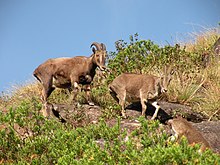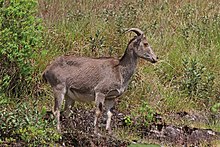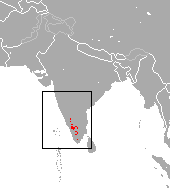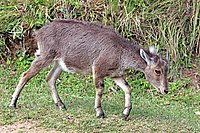| Nilgiri tahr | |
|---|---|

| |
| Male (left) | |

| |
| Female in Eravikulam National Park | |
| Conservation status | |
 Endangered (IUCN 3.1) | |
| Scientific classification | |
| Domain: | Eukaryota |
| Kingdom: | Animalia |
| Phylum: | Chordata |
| Class: | Mammalia |
| Order: | Artiodactyla |
| Family: | Bovidae |
| Subfamily: | Caprinae |
| Tribe: | Caprini |
| Genus: | Nilgiritragus Ropiquet & Hassanin, 2005 |
| Species: | N. hylocrius |
| Binomial name | |
| Nilgiritragus hylocrius (Ogilby, 1838) | |

| |
| Distribution of Nilgiri tahr | |
| Synonyms | |
|
Hemitragus hylocrius | |
The Nilgiri tahr (Nilgiritragus hylocrius) is an ungulate that is endemic to the Nilgiri Hills and the southern portion of the Western and Eastern Ghats in the states of Tamil Nadu and Kerala in southern India. It is the only species in the genus Nilgiritragus and is closely related to the sheep of the genus Ovis.
It is the state animal of Tamil Nadu.
Etymology
The genus name Nilgiritragus is derived from the Sanskrit words Nila(blue) and Giri(mountains) meaning "blue hills" and the Greek word trágos meaning "goat".
Taxonomy
The Nilgiri tahr was described as Capra warryato by Gray.
Taxonomy
The species was formerly placed in the genus Hemitragus together with the Himalayan tahr (H. jemlahicus) and the Arabian tahr (Arabitragus jayakari). A 2005 phylogenetic analysis showed that the Himalayan and Arabian tahr are sisters of the genus Capra while the Nilgiri tahr is a sister of the genus Ovis and it was therefore separated into the monotypic genus Nilgiritragus in 2005. The divergence from the common ancestor of Ovis and Nilgiritragus is estimated to about 2.7-5.2 million years ago. Estimates point to the genetic separation of the populations north (Nilgiris) and south (Anamalais) of the Palghat Gap about 1.5 million years ago.
Description
 Juvenile
Juvenile Female
Female
The Nilgiri tahr is a stocky goat with short, coarse fur and a bristly mane. Males are larger than females and of darker colour when mature. Both sexes have curved horns, reaching up to 40 cm (16 in) for males and 30 cm (12 in) for females. Adult males weigh 80 to 100 kg (180 to 220 lb) and stand about 100 cm (39 in) tall at the shoulder. Adult males develop a light grey area on their backs, thus are called "saddlebacks".
Distribution and habitat
The Nilgiri tahr can be found only in India. It inhabits the open montane grassland habitat of the South Western Ghats montane rain forests ecoregion. At elevations from 1,200 to 2,600 m (3,900 to 8,500 ft), the forests open into large grasslands interspersed with pockets of stunted forests, locally known as sholas. These grassland habitats are surrounded by dense forests at the lower elevations. The Nilgiri tahrs formerly ranged over these grasslands in large herds, but hunting and poaching in the 19th century reduced their population.
Threats
The Nilgiri tahr is primarily threatened by habitat loss and disturbance caused by invasive species, and in some sites by livestock grazing, poaching and fragmentation of the landscape.
Conservation
As few as 100 Nilgiri tahrs were left in the wild by the end of 20th century. Since that time, their numbers have increased somewhat; in a comprehensive study of the Nilgiri tahr population in Western Ghats, the WWF-India has put the population at 3,122. Their range extends over 400 km (250 mi) from north to south, and Eravikulam National Park is home to the largest population. Per the wildlife census conducted by Kerala forest department in association with volunteers from College of Forestry and Veterinary Science under Kerala Agricultural University, from April 24–28, 2014, the number of animals in Eravikulam National Park has increased to 894 individuals. This is the highest ever count recorded in the national park, with the first census in 1996 finding only 640 tahrs. The other significant concentration is in the Nilgiri Hills, with smaller populations in the Anamalai Hills, Periyar National Park, Palani Hills, and other pockets in the Western Ghats south of Eravikulam, almost to India's southern tip. A small population of tahrs numbering around 200 is known to inhabit the Boothapandi, Azhakiyapandipuram, Velimalai, Kulasekaram, and Kaliyal Ranges in the Kanyakumari district of Tamil Nadu and another small herd of less than 30 animals is known to inhabit Ponmudi Hills in Trivandrum district of Kerala.
See also
References
- ^ Alempath, M.; Rice, C. (2008). "Nilgiritragus hylocrius". IUCN Red List of Threatened Species. 2008: e.T9917A13026736. doi:10.2305/IUCN.UK.2008.RLTS.T9917A13026736.en. Retrieved 19 November 2021.
- ^ Prater, S. H. (1971) . The book of Indian Animals. Bombay: Bombay Natural History Society.
- Liddell, H. G.; Scott, R. (1940). "τράγος". A Greek–English Lexicon (Ninth ed.). Oxford: Oxford University Press.
- Hamilton, G. D. (1892). Hamilton, E. (ed.). Records of sport in southern India chiefly on the Annamullay, Nielgherry and Pulney mountains, also including notes on Singapore, Java and Labuan, from journals written between 1844 and 1870. London: R. H. Porter. p. 284. OCLC 4008435.
- Ropiquet, A. & Hassanin, A. (2005). "Molecular evidence for the polyphyly of the genus Hemitragus (Mammalia, Bovidae)". Molecular Phylogenetics and Evolution. 36 (1): 154–168. Bibcode:2005MolPE..36..154R. doi:10.1016/j.ympev.2005.01.002. PMID 15904863.
- Joshi, Bheem Dutt; Matura, Rakesh; M. A., Predit; De, Rahul; Pandav, Bivash; Sharma, Vipin; Nigam, Parag; Goyal, Surendra Prakash (2 January 2018). "Palghat gap reveals presence of two diverged populations of Nilgiri tahr ( Nilgiritragus hylocrius ) in Western Ghats, India". Mitochondrial DNA Part B. 3 (1): 245–249. doi:10.1080/23802359.2018.1436990. ISSN 2380-2359. PMC 7800121. PMID 33474132.
- "Nilgiri tahr population over 3,000: WWF-India". The Hindu. 3 October 2015.
- "Munnar Hill Station". Kerala Tourism. Archived from the original on 18 January 2014. Retrieved 21 June 2012.
- "Bonnet Macaque tops in wildlife survey in Kanyakumari district"
- "Squeezing Life out of Ponmudi"
Further reading
- Rice, G. Clifford, Reproductive biology of Nilgiri tahr, Journal of Zoology, London (PDF Archived 20 June 2013 at the Wayback Machine)
External links
- ARKive - images and movies of the Nilgiri tahr (Hemitragus hylocrius)
- Nilgiri tahr information (archived)
| Taxon identifiers | |
|---|---|
| Hemitragus hylocrius | |